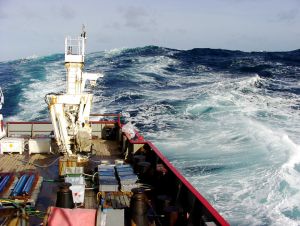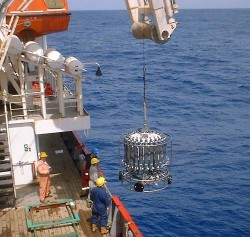|
|
 |
|
|
|
 |
 |
|
|
 |
Dimethylsulfide from algae
The climate impact of phytoplankton and oceanic ecosystems
|
 |
 |
|
1. The sea is not only a wide area of water, but also full of life and in permanent exchange with the air. Photo: Tom Bell
|
|
The forest of the ocean and its smell
We know from the trees that they take up carbon dioxide in order to grow and that they releases a certain smell, the smell of the forests. When trees smell, they release organic compounds. The plants in the ocean do the same. They take up carbon dioxide and you can smell the sea if you go to the coast. Certainly you do not smell the water, but certain gases coming from the plants in it.
|
|
If you would like to see more phytoplankton organisms, please visit the website of Mats Kuylenstierna and Bengt Karlson, where the two pictures are taken from.  Click here! Click here!
There is about a factor of 1000 less biomass in the oceans than on land. However, phytoplankton lives only for one week and dies again, taking a lot of nutrients with it to the deeper sea if not eaten up by bacteria. Because of the fast life cycle of phytoplankton there is as much organic material formed in a year in the oceans as on land.
See a movie:  phytoplankton moving phytoplankton moving
|
The research group of Prof. Liss at Univesity of East Anglia, partner in ACCENT, has been making measurements of DMS in the ocean since 1984. But why? We see, that phytoplankton is a very basic component in the oceanic food chain. But what about DMS? Climate scientist have learned that this gas, produced by phytoplankton, is one of the most important sulphur-containing gases in our atmosphere. In the air these gases are oxidised and form particles consisting primarily of sulfuric acid. The particles contribute to the acidity of our atmosphere and allow clouds to develop over the ocean (see context). Cloud formation and its influence on the radiation coming from the sun and going back from the Earth are important for the regulation of our climate.
|
 |
 |
 |
|
4. Research cruises are not always calm and scientific events. Tom Bell took this photo during big seas with high waves.
Click it in order to have a larger view! (160 K)
|
|
|
Table: Global sulfur contributions to the air following Rafel Simó (2001)
Nowadays humans emit more sulphur compounds to the atmosphere than nature does. But oceanic DMS makes still the largest contribution to the overall sulphur burden in the air, since it stays for a longer time in the atmosphere than human emissions do.
| Source |
global S emission
[Teragramme S per year]
(mean, range) |
Contribution to
emissions [%] |
Contribution to
sulphate burden [%] |
| Man-made |
70 (60 - 100) |
70 |
37 |
| Volcanic |
7 (4 - 16) |
7 |
18 |
| Biogenic |
22 (15 - 50) |
23 |
42 |
> 90% of the biogenic emissions is oceanic DMS |
 |
 |
|
5. Tom Bell, scientists at University of East Anglia and reviewer of this article, during an analysis.
|
|
 |
Does phytoplankton want to regulate the climate?
According to Darwin's theories of mutation and selection, a species survives in the long term if it influences the environment in a way which is supportive for its own survival and bad for competitors. Becoming aware of which important impacts the release of DMS has on our climate system, scientists thought that phytoplankton releases DMS in order to regulate the climate over the ocean to its own benefit (CLAW-theory).
|
Since also humans change the climate (global warming of air and sea) and change the conditions in the oceans (for example, the discharge of nutrients) the feedback from phytoplankton and DMS cycles is certainly of interest. This was the reason why this phenomenon has been studied in more than 150 research cruises and results have been published in more than 1000 publications.
Table:
Example of a protocol from CTD sampling. From depth, remaining light and organsims in the bottles we can learn about their living conditions. The fraction of light penetrating the water to a certain depth is an example and depends on, how biologically active the water is and how many particles it contains. In coastal areas the 0.1% level can be much shallower.
|
 |
|
|
Bottle number |
% of surface light |
Depth [m] |
|
12 |
100 |
0/5 |
|
11 |
50 |
10 |
|
10 |
30 |
25 |
|
9 |
15 |
40 |
|
8 |
5 |
60 |
|
7 |
1 |
100 |
|
6 |
0.1 |
150 |
|
5 |
<0.1 |
200 |
|
 |
 |
 |
|
6. a + b) CTD sampling: In order to learn more about the life in the ocean scientists takes samples. The sampling vessel measures Conductivity, Temperature and Depth (CTD) and is equipped with 12 or more sampling bottles which can collect water samples, including the organisms from different depths in the sea.
Photo top: NASA, bottom: Tom Bell.
Please click the photo for a larger view. (70 K)
|
|
|
What do we know now?
We now understand that mechanisms in the marine food network are more complex. DMS in the air is thought to have an impact on climate and this is likely to feedback on phytoplankton growth. However, the situation is not as simple as indicated in scheme 1 below. Phytoplankton does not release DMS immediately. It releases the compound dimethylsulfoniopropionate (DMSP), which is chemically converted into DMS under certain conditions. DMSP does not go to the air. It serves for the communication of marine species (signal compound) and plays a role in osmoregulation. (It stops cells from bursting due to variations in the saltiness of ocean waters.). Moreover, not only phytoplankton but also bacteria play a role in the regulation of DMSP release and conversion into DMS after the death of phytoplankton cells.
The reality is also more complicated than the first CLAW hypothesis assumed because different phytoplankton species react in different ways to light and temperature changes, while not all of them produce the same amounts of DMSP.
|
|
We can now say that many parts of the food network in the oceans and its interactions have to be understood if we would like to explain how exactly the living organisms in the oceans interact with the climate system. It is helpful to know this for many reasons: Humans warm the oceans, humans change the nutrient composition in particular at the coasts, humans add carbon dioxide to the air which makes the oceans acid (carbonic acid) and humans add now even more sulphur to the air than the natural emissions from phytoplankton and volcanoes do together. We have even thought about feeding phytoplankton in the oceans to make it grow and take up more carbon dioxide in order to reduce the greenhouse effect.
We see that there are very complicated feedback loops in the marine life community, which have consequences not only for small organisms and fish in the sea but also for our climate.
|
Author: Elmar Uherek - Max Planck Institute for Chemistry, Mainz
Reviewer: Tom Bell - University of East Anglia, Norwich
|
|
 |
|







